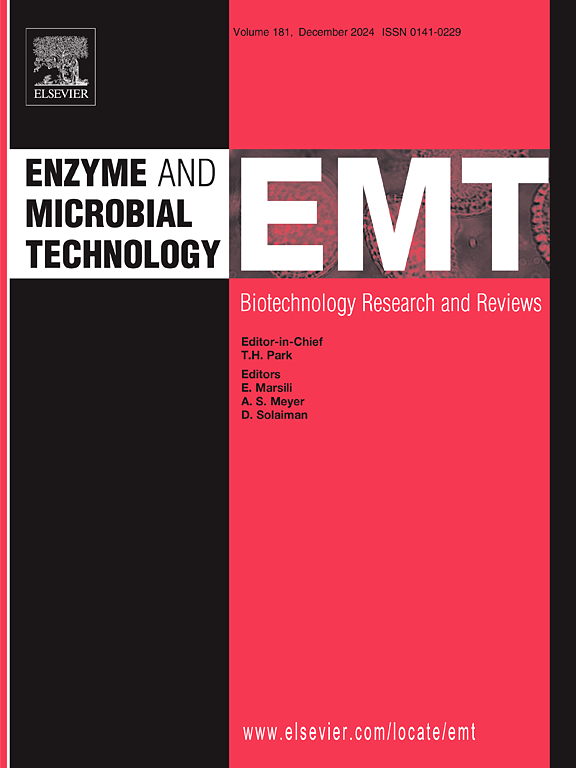硫醇杆菌 O-α-糖苷酶合成高水溶性白藜芦醇 3,4′-α- 二糖苷的作用模式
IF 3.4
3区 生物学
Q2 BIOTECHNOLOGY & APPLIED MICROBIOLOGY
引用次数: 0
摘要
本研究采用超活性 O-α-糖苷酶(MalA-D416R/Q450S)和α-吡喃葡萄糖酰氟作为供体底物,酶法合成了白藜芦醇-3,4′-O-α-二葡萄糖苷(RDG)。MalA-D416R/Q450S 在含有 20% DMSO 的 100 mM Tris-HCl(pH 9.5)、45°C 条件下对白藜芦醇的转糖基化率达到最大。由于白藜芦醇的 4′-OH基团的 pKa 低于 3-OH基团,因此 4′-OH基团在碱性 pH 值下更具亲核性,导致糖基化更倾向于 4′-OH位点而不是 3-OH位点。这种偏好使白藜芦醇 3-O-α-葡萄糖苷(R3G)成为比白藜芦醇 4′-O-α-葡萄糖苷(R4′G)更有效的受体,导致白藜芦醇 3-O-α-葡萄糖苷(R3G)的产量微乎其微,因为当供体和受体底物的比例为 2:1 时,它在第二次转糖基化反应中完全消耗掉了。在制备规模的反应中,分离出了 R4′G 和 RDG,产量分别为 41.2 % 和 43.3 %。RDG 的水溶性超过 1.67 M,与白藜芦醇相比提高了 9,800 多倍。在使用大鼠肠道α-糖苷酶进行的水解实验中,白藜芦醇的α-葡萄糖苷(R4′G 和 RDG)被完全脱糖为苷元。本文章由计算机程序翻译,如有差异,请以英文原文为准。
Action pattern of Sulfolobus O-α-glycoligase for synthesis of highly water soluble resveratrol 3,4′-α-diglucoside
This study presents the enzymatic synthesis of resveratrol-3,4′-O-α-diglucoside (RDG) using a hyperactive O-α-glycoligase (MalA-D416R/Q450S) and α-glucopyranosyl fluoride as the donor substrate. The transglycosylation rate for resveratrol by MalA-D416R/Q450S was maximized in 100 mM Tris-HCl (pH 9.5) containing 20 % DMSO at 45°C. Because the pKa of the 4′-OH group of resveratrol is lower than that of the 3-OH group, the 4′-OH group is more nucleophilic at the alkaline pH, leading to a preference for glycosylation at the 4′-OH site rather than the 3-OH site. This preference makes resveratrol 3-O-α-glucoside (R3G) as the more efficient acceptor than resveratrol 4′-O-α-glucoside (R4′G), resulting in negligible production of resveratrol 3-O-α-glucoside (R3G) due to its complete consumption in the second transglycosylation reaction when using a 2:1 ratio of donor to acceptor substrates. From a preparative scale reaction, R4′G and RDG were isolated with yields of 41.2 % and 43.3 %, respectively. The water solubility of RDG exceeded 1.67 M, which represents more than a 9,800-fold improvement compared to resveratrol. In a hydrolysis experiment using intestinal α-glycosidase from rat, the α-glucosides of resveratrol (R4′G and RDG) were completely deglycosylated to the aglycone.
求助全文
通过发布文献求助,成功后即可免费获取论文全文。
去求助
来源期刊

Enzyme and Microbial Technology
生物-生物工程与应用微生物
CiteScore
7.60
自引率
5.90%
发文量
142
审稿时长
38 days
期刊介绍:
Enzyme and Microbial Technology is an international, peer-reviewed journal publishing original research and reviews, of biotechnological significance and novelty, on basic and applied aspects of the science and technology of processes involving the use of enzymes, micro-organisms, animal cells and plant cells.
We especially encourage submissions on:
Biocatalysis and the use of Directed Evolution in Synthetic Biology and Biotechnology
Biotechnological Production of New Bioactive Molecules, Biomaterials, Biopharmaceuticals, and Biofuels
New Imaging Techniques and Biosensors, especially as applicable to Healthcare and Systems Biology
New Biotechnological Approaches in Genomics, Proteomics and Metabolomics
Metabolic Engineering, Biomolecular Engineering and Nanobiotechnology
Manuscripts which report isolation, purification, immobilization or utilization of organisms or enzymes which are already well-described in the literature are not suitable for publication in EMT, unless their primary purpose is to report significant new findings or approaches which are of broad biotechnological importance. Similarly, manuscripts which report optimization studies on well-established processes are inappropriate. EMT does not accept papers dealing with mathematical modeling unless they report significant, new experimental data.
 求助内容:
求助内容: 应助结果提醒方式:
应助结果提醒方式:


